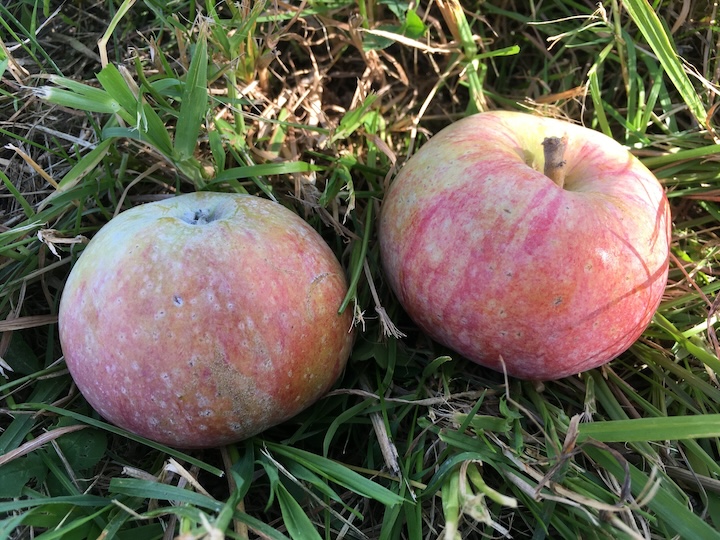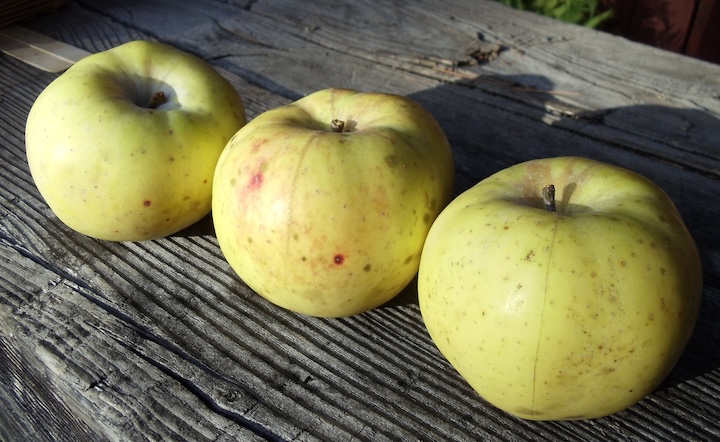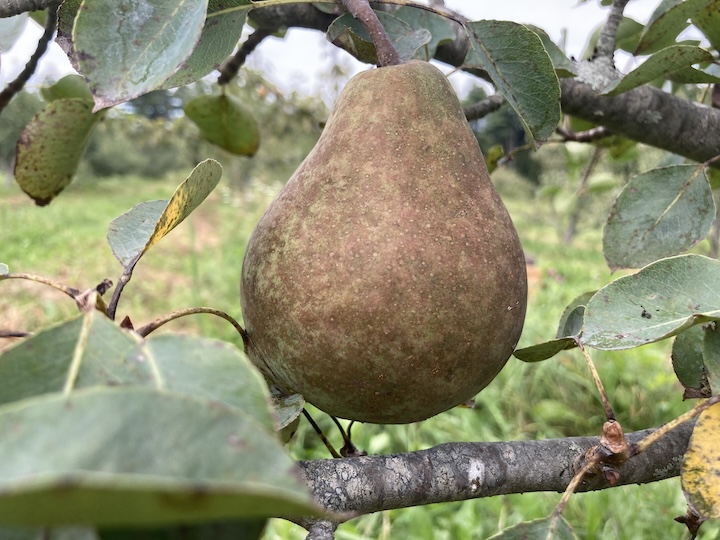By C.J. Walke, Orchard Program Manager
As summer rolls into fall, we start to see the bulk of the apple and pear varieties in MOFGA’s Maine Heritage Orchard in Unity beginning to ripen during September and October. In the fall, it always feels like such a long time has passed since the trees were blooming in May. In that time many variables can occur to disrupt pollination, fruit set, growth, and ripening (spring freezes, hail storms, insect pressure, disease), making us thankful for the fruit at harvest, especially after laboring all summer to arrive at this point.

We, the orchard crew, spend many summer hours every day beneath the trees, weeding, composting, mulching, and checking for borers, so when fruit is ready to harvest, we happily move from beneath the tree and into the canopy to pick, taste, compare, and evaluate. Many trees in the orchard are still young and not in their fruit-bearing years, but more mature each year, keeping us on our toes and scouting for ripe fruit. We are always asked about our favorite varieties and though it is so difficult to choose, we would like to share a few Maine apple and pear varieties that would make good additions to a home orchard.
Pears and apples are commonly grouped by their ripening times (summer, fall, winter) and characterized by their best uses (fresh eating, cooking, storage), which we’ll use in these descriptions, starting with summer apples. Cole’s Quince and Moses Wood are two favorite summer apples in the Maine Heritage Orchard. Cole’s Quince was introduced around 1840 by Captain Henry Cole of Cornish, Maine. Its large, ribbed yellow fruit is similar in appearance to a quince, possibly influencing the name. It is an excellent summer cooking apple, making great sauce and pies. Moses Wood, named after an early fruit explorer from Winthrop, Maine, was introduced before 1830. It is more of a tart dessert apple with juicy flesh and also makes good pies.

Fletcher Sweet and Sweet Sal are two fall favorites that are sweet and crisp picked fresh from the tree. Fletcher Sweet is credited to the Jonathan Fletcher Farm in Lincolnville, Maine, during the 19th century. Its green fruit is crisp and juicy and stores into December. Sweet Sal is a seedling of Northern Spy, discovered by orchardist Morris Towle of Winthrop and named for his daughter. A wonderfully sweet apple, it tends to bear late but stores well, though a favorite of turkeys and porcupines in the MOFGA orchards.
Another fall apple worth mention and propagation is a possible Red Delicious seedling named I-95, discovered around 1987 by fruit explorer Jack Kertesz, who found it growing on a sucker from an ornamental crab by an on-ramp to Maine Interstate 95 in Waterville. One of the “younger” apples in MOFGA’s orchards, its crisp and balanced flavor makes for great eating, and it stores well into winter. Kertesz, also MOFGA’s current landscape coordinator, admires trees that thrive in unlikely places and regularly shares fruit found from oddball trees growing in parking lots or behind dumpsters or in random urban spaces. I-95 may not be more than a century old like most varieties in this article, but it has a great story and hopefully survives to that ripe old age.
The last two apple varieties we suggest are late-season varieties that store well into winter: Gray Pearmain and Black Oxford. Gray Pearmain is a “child” of Tolman Sweet and is believed to have originated around Skowhegan, Maine, before 1870. It’s a wonderful fresh eating apple with a hint of pear flavor and stores all winter. The original trees were at The Apple Farm in Fairfield, Maine — many thanks to Marilyn and Steve Meyerhans who have been great collaborators with the Maine Heritage Orchard crew over the years. Black Oxford is a winter apple from Paris, Maine, discovered around 1790; recent DNA profiling determined its parentage as Hunt Russet and Blue Pearmain. Its fruit catches the eye with its deep purple and blackish color, and it makes excellent pies and sauce. Though it can be a little hard and firm fresh off the tree, the fruit sweetens nicely after a month in storage and continues to improve over winter. By April or May, the fruit may be a little wrinkled and soft, but the flavor will continuously surprise you!
A home heritage orchard would not be complete without a couple pears added into the mix, and though we typically focus on apples, we have about a dozen varieties currently growing in the Maine Heritage Orchard and a few dozen more grafted this spring and growing in our nursery. Pears are a delicious addition to home fruit growing, and the trees can typically handle heavier soils (i.e., clay soils), which are common throughout the state, especially along the Maine coast, better than apples. Pears have their own insects and diseases to be aware of, but they are rugged trees and can live longer than apple trees.

One of our favorite Maine pears is Stacyville, a summer pear, typically picked in mid-August and ripened in storage. The original tree in the northern Maine town that shares its name is estimated by some to be a couple hundred years old, which is older than the incorporation dates of towns in that area. Its origins are unknown, but local historians guess it may have grown from a seed planted by French fur traders that were traveling in the area at that time.
Another amazing pear is provisionally named June’s Pear, which ripens in mid-September; it is great for fresh eating and cooking, and is pest- and disease-resistant with very little cracking or damage. This very large pear is named after June LaCombe of Pownal, Maine, where the original tree stands in her backyard, though two other grafted trees have been found in nearby orchards. We are still working to determine the identity of this wonderful pear, but it is worthy of cultivation, nonetheless.
Choosing favorites is always a challenge when there are so many excellent varieties with different seasons, characteristics, and stories, but this selection of heritage apples and pears is a good place to start for an interested grower researching varieties for the home orchard. Much credit is due to Fedco Trees for their well organized and detailed catalog and website, as well as members of the Maine Heritage Orchard crew who are dedicated to our efforts and bring their decades of experience.
This article was originally published in the fall 2024 issue of The Maine Organic Farmer & Gardener. Browse the archives for free content on organic agriculture and sustainable living practices. Subscribe to the publication by becoming a member!
